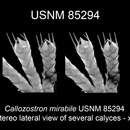en
names in breadcrumbs


“9. Callozostron Wright, 1885
FIGURE 50–X
Callozostron Wright, 1885:690–691.—Studer, 1887:48.—Wright and Studer, 1889:48.—Versluys, 1906:124.—Kükenthal, 1912:328–339; 1915:152 [key to genus and species]; 1919:449–450 [key to genus and species]; 1924:306 [key to genus and species].—Bayer, 1961:295 [illustrated key to genus]; 1981b:936 [key to genus].—Bayer and Stefani, 1989:455 [key to genus].—Bayer, 1996b:151–152 [revision of genus, key to species].
Diagnosis. Colonies unbranched (type species) or sparsely dichotomously branched. Calyces arranged in whorls of up to 14, the bases of adjacent calyces within a whorl often fused, but not as leaves; calyces stand perpendicular to branch or slightly inclined upward. Well developed operculum present, the operculars having a smooth inner face. Eight marginal scales present, at least four of which have extremely long, smooth apical spines that do not fold over the operculum (Figure 5p, s–t); a second ring of spined submarginals may also be present. Polyp covered with eight longitudinal rows of body wall scales; outer surface of scales smooth. Coenenchymal scales arranged in one layer.
DISCUSSION. Four species are known in this genus (Table 4), all of which are restricted to the Antarctic and subantarctic regions. Bayer (1996b) noted the resemblance of Callozostron to Ainigmaptilon, particularly with regard to the basal fusion of their calyces; however, whereas some polyps of Callozostron are basally united, as is the case of a few other primnoid genera (e.g., Arntzia, Onogorgia, Ophidiogorgia), the calyces of Ainigmaptilon are supported on distinct, fleshy, leaf-like structures. Furthermore, the marginal scales of Callozostron are much larger than those in Ainigmaptilon and have prominent apical spines. Finally, Callozostron has a typical infolding operculum, whereas the opercular scales of Ainigmaptilon bear such long apical spines that they cannot fold over the tentacles as most opercula do. Bayer (1996b:151–152, 200) also compared Callozostron to Convexella (as Primnoella magelhaenica), Callozostron differing from that genus in having fused basal calyces and spinose marginal scales that do not fold over the operculum.
DISTRIBUTION. Antarctic, South Georgia, New Zealand, 1,354–3,876 m.
TYPE SPECIES. C. mirabile Wright and Studer, 1889, by monotypy. The type is deposited at the BM (1889.5.27.33). The type species was recently redescribed and illustrated by Bayer (1996b)."
(Bayer & Cairns, 2009)